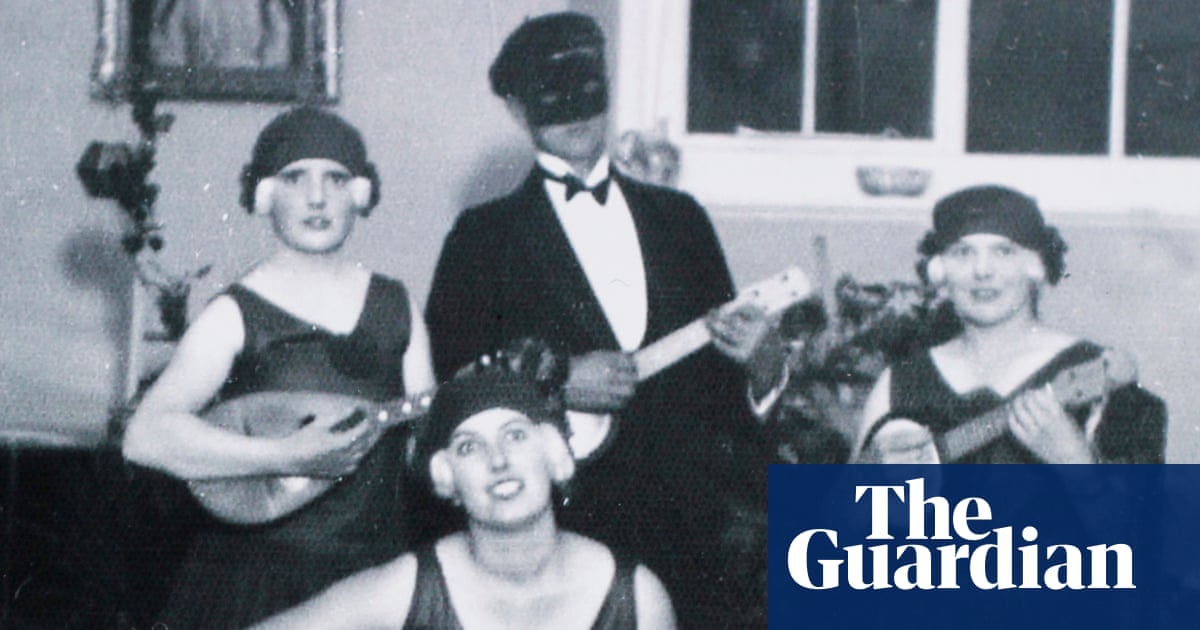
Hanging from a drawing pin in Shalford Mill, in a tiny room just a couple of metres above its mighty water wheel and the tumbling River Tillingbourne, is a brown paper bandit’s mask. It is almost invisible in the shadows of the hefty 18th-century beams, and its aura of intrigue seems at odds with this chocolate box National Trust site, tucked at the end of a quaint, daffodil-dotted lane in deepest Surrey. Yet the mask is part of the reason this beautiful building stands today.
It is a relic from a theatrical arsenal worn by Ferguson’s Gang: a clandestine society active from the late 1920s to the postwar years. Far from their criminal-sounding name, they were actually a bunch of well-to-do guerrilla conservationists, who conspired to save England’s history for posterity for the National Trust. What’s more, they were young women.
Ferguson’s Gang (who Ferguson was remains a mystery) had a penchant for playfulness. Along with the masks, they kept their identities secret, and coined impenetrable pseudonyms for themselves, such as the Bludy Beershop, Bill Stickers and Red Biddy. They delivered the donations they raised through their wealthy contacts in disguise, with surprise stunt “hits” on the Trust’s bigwigs and offices. Most implausible of all are the props the gang used to deliver their spoils, which quickly garnered publicity for the Trust: hessian sacks full of silver coins, gin bottles, cigars inside which banknotes were rolled, and, on one occasion, a metallic pineapple. This was presented to the Trust’s chairman, Lord Zetland, at its 1939 AGM, where it was fleetingly mistaken, with some alarm, for an IRA bomb. In fact, the pineapple contained a £100 note.
But for all their eccentricity, Ferguson’s Gang were also passionately committed. After saving Shalford Mill – by first securing it for the charity, then paying to repair and maintain it – a string of other historic sites and landscapes followed, at a time when preservation of historic architecture and public green spaces was little-valued and largely unprotected by law.
Polly Bagnall, 61, grew up in Shalford Mill. Her grandfather John Macgregor, a conservation architect, was employed by the National Trust and adopted as an honorary member by the gang who nicknamed him “the Artichoke”.
He and his young family, including Bagnall’s mother, Joanna, rented half the mill, as Bagnall’s sister, Anna Pohorely, 65, continues to do today. Despite the family folklore, they knew little of the gang until a few years ago when Bagnall, an artist, started researching for a book she was to co-write on the gang. Yet even now these women remain an enigma.
“They were mavericks,” Bagnall says. “Activists with a small ‘a’. They did things their own way. But their passion and infectious sense of fun meant they achieved so much.”
Leading me up dusty timber ladders across the mill’s four uneven floors, Pohorely says: “We only knew they were a strange group of women who were all very benevolent.”
Their disguises, Bagnall believes, were born of both necessity and play. “I think they felt they wouldn’t have been taken seriously as women; many thought they were men,” she says.
As one member, Brynnie Granger, later explained, still under her pseudonym Sister Agatha: “We cared about helping to save England and wanted to be involved in something of permanent value … But we were in our early 20s and it was fun.”
The founder of the gang was Peggy Gladstone, later Pollard, AKA Bill Stickers (inspired by the common message warning “bill stickers” against pasting posters in public). She was a brilliant Cambridge student, a Cornish-language poet and great, great niece of prime minister William Gladstone. Her co-conspirators were fellow highly educated and wealthy pals: Granger, Rachel Pinney (a developmental psychologist), Joy Maw, Eileen Bertram Moffat and Ruth Sherwood.
It was over a picnic in 1927 that these women first discussed the creation of a gang to preserve England. Pollard was influenced by the architect Clough Williams-Ellis, whose 1928 book, England and the Octopus, lambasted the “tentacles” of urbanisation that were creeping into the rural landscape and destroying village life.
Around the same time, a national appeal was launched to save Stonehenge, which was then pitifully neglected and damaged. The women seized upon the stones as their symbol of preservation, regularly visiting the site for “rituals” – another of their quirks. They coined the phrase: “England is Stonehenge not Whitehall.”
They fundraised among their wealthy circles and recorded their exploits in a minute book that they called the Boo (there wasn’t enough space for the “k”). An oath was also taken: “I swear to follow Ferguson in preserving England and frustrating the Octopus.”
In September 1931, Pollard and Granger were visiting a friend, Arthur Godwin-Austen, in Surrey, and spied Shalford Mill on his family estate. Already threatened by suburban sprawl, the defunct watermill was crumbling. The gang convinced Godwin-Austen to give it to them, then offered to endow it to the National Trust and raise £500 for repairs. The Artichoke started work, moving in at weekends, and the games began.
Regularly, the women would hold meetings on the mill’s “stones floor” perched above the 12ft-diameter water wheel. They would sit around a hefty circular millstone, their knees meeting in the middle. “They never wanted more members than would fit,” says Pohorely. I can picture them dwarfed by the giant spurred wheels and the magnificent oak trunk spearing the room, which would all have been sold for timber if not for them.
They slept next door in their “cell”, a small room furnished with bunk beds rescued from a Zeppelin. Pohorely lifts a rug; through the floorboards I see the river. They supplemented their earnest conversations with carefree make-believe, practising elaborate midnight ceremonies and feasting. “There’d be a van from Claridge’s following them with hampers,” says Bagnall. “They recorded in the Boo what they ate: things like lychees, pineapples; one Easter they cooked a Tuscan lamb.”
Bagnall’s mother recalled sleeping on the floor below and hearing their stomping. They would act out ritual “hauntings”, banging a ceremonial staff and watching the sunrise before “de-robing” to bathe. “She heard them chanting verse,” describes Bagnall. “The children were a little frightened.” For these unconventional women, some lesbian or bisexual, the mill also meant freedom. “They were doing things they felt made a difference, but also fulfilling their need for inclusivity,” says Bagnall.
After Shalford Mill (which is temporarily closed to the public), the gang went on to save Newtown’s Old Town Hall on the Isle of Wight, which dates from 1699, and Priory Cottages in Oxfordshire, a row of 14th-century former monastic buildings. Both are still National Trust-owned. They also rescued the stunning Cornish coastal landscapes around the cliffs of Mayon and Trevescan, and Frenchman’s Creek, coaxing landowners to hand them over to the Trust rather than sell to developers.
The gang’s story is now being told in The Mysterious Tale of Ferguson’s Gang, part of the National Trust’s latest podcast series. It is presented by James Grasby, a Trust curator of 36 years who nevertheless knew little about them. “It has been immensely inspiring,” he says. “At that time a lot of historic buildings were simply seen as a liability. There was no statutory protection; the listed building system wasn’t in place. We saw incredible losses of very precious places.”
He sounds rather wistful – for similar abandon among present-day members, perhaps? “Imagine rushing into an AGM and throwing a pot of cash down with your mask on,” he says. “It was the spirit of a latter-day Robin Hood.”
By 1935, the gang’s profile was so high that Pollard’s brother, Bobby, posed as Ferguson in a mask to make an appeal for the National Trust on BBC radio. Hundreds donated and membership leapt by 20%. The second world war interrupted the gang’s mission, however, and their exploits ended in the late 40s. But their message had been heard. “Attitudes had shifted in conservation, there was more legislation, and they had contributed to that,” says Bagnall.
Members of Ferguson’s Gang continued to meet at the mill as late as the 1980s, but, miraculously, none of them revealed their identities to public. It was finally Pollard who came clean, in a letter to a newspaper that she instructed should only be published after her death in 1996. In verse, she admitted, modestly: “We dun it for the National Trust / So many years ago.”












